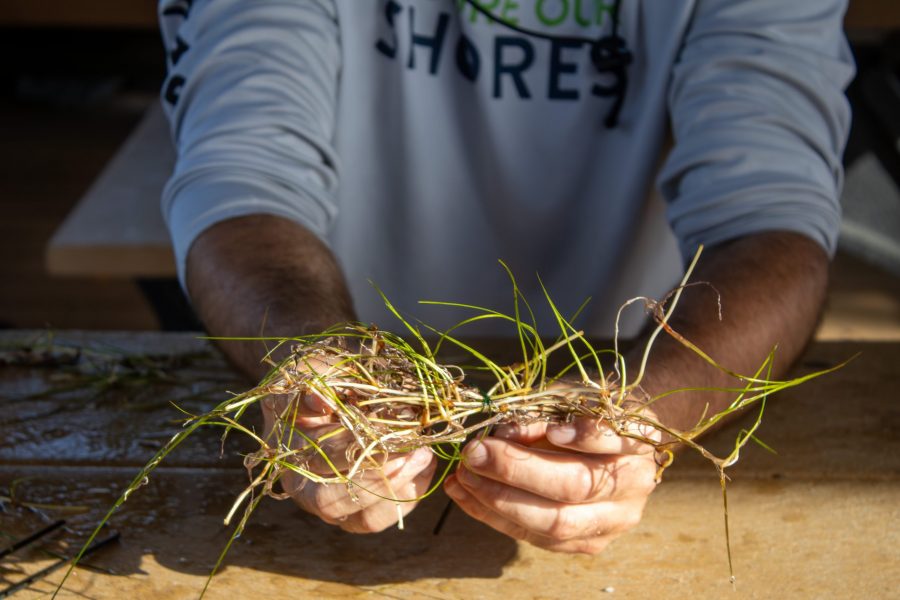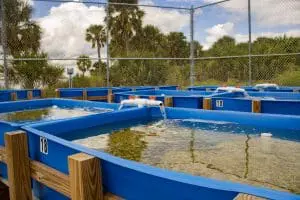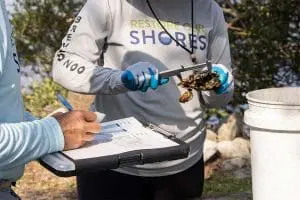

The Restore Our Shores team works hard to bring our Indian River Lagoon’s ecosystem back into balance. Their work goes beyond the boots-on-the-ground action of building oyster reefs, monitoring seagrass or planting clams. ROS also leads research work that helps guide the work in the lagoon – our own and our partners. Some of this research work is taken on by the team’s amazing interns! Read on to learn more about their experiences and work with ROS.
Interested in interning with us? Visit https://brevardzoo.org/volunteer-programs/internships/ to learn more!
Name: Skyler Alkayaly
School and major: UCF Biology Major
Why did you decide to intern with Restore Our Shores? I decided to intern with Restore Our Shores because I had a big interest with working within the Indian River Lagoon. I took a Florida ecology course and there was a section just about the lagoon and I really wanted to be a part of restoration efforts.

How did you come up with your idea for your project? What question is your project trying to answer? I didn’t know very much about seagrass and when I did my own research, I found that there were still my questions that needed to be answered. I was curious about the sediment characteristics for seagrass and then worked in collaboration for the bigger picture of my project. My project is trying to answer what organic matter and grain size ratio is best for seagrass growth in a nursery setting.
How is your project trying to answer that question? With my project I’m using two different sediment types, quarry sand (low levels of organic matter) and lagoon sand (high levels of organic matter). Both sediments have three different treatments at different grain sizes and seagrass is planted into each container and monitored for growth.
Has anything surprised you about your project so far? Any interesting results? I found within my results that my unsieved quarry sand was the worst performing treatment during this project. This is interesting since this is what is being used for the ROS seagrass nursery. I believe some larger fragments within the quarry sand may limit how much seagrass may grow.
How has your ROS internship impacted you so far? Has it influenced your after graduation plans at all? My internship at ROS has influenced my view of field work, I wasn’t quite sure if that was something I wanted to look into before but since experiencing it I very much enjoy that type of work. It has also influenced a new passion for environmental work that I didn’t know I had.
Name: Kylie Eagan
School and Major: Valencia College, Plant Science – Horticulture
Why did you decide to intern with Restore Our Shores? I was looking for the next step in getting involved with environmental work and learning more about conservation efforts. I saw this internship as a way to gain hands-on experience, explore potential career paths, and really get my foot in the door.
How did you come up with your idea for your project? In school, we studied plant physiology and how different plants require specific macro and micronutrients to support healthy growth. After talking with a few team members at ROS, I realized there was very limited information available on what promotes seagrass growth. I designed my project to help provide some direction on where to start and what kinds of nutrients might be beneficial.
What question is your project trying to answer? My project is assessing the effects of different fertilizers on Halodule wrightii.
How is your project trying to answer that question? After doing research and speaking with Dr. Austin Fox at Florida Institute of Technology and ROS’s Tyler Provoncha, I decided to test several fertilizer types. These included Osmocote Plus, which is commonly used in seagrass nurseries; two orchid fertilizers (based on research suggesting orchids are among the closest terrestrial relatives of seagrasses); and an algae fertilizer called F/2, which I prepared in the lab. I also created eight different variations of F/2, each missing a single component, to see if the absence of specific nutrients would impact growth.
Has anything surprised you about your project so far? Any interesting results? One surprising result is that low dosages of fertilizer seem to work best for seagrass. Interestingly, the control group—with no fertilizer at all—showed some of the best growth. Also, the group missing iron saw the fastest decline, which could suggest that iron levels in the lagoon are critical for seagrass health.
How has your ROS internship impacted you so far? Has it influenced your post-graduation plans? I’ve made some great connections and learned a lot about real-world conservation efforts. This experience has opened up opportunities I didn’t expect when I first applied. It’s helped me start exploring conservation as a potential career path, and I’ve been doing more research into where I’d like to go after graduation. Conservation is now firmly on the list of possible directions for my future.
 Name: Alex Warren
Name: Alex Warren
School and major: University of North Florida, Coastal and Marine Biology
Why did you decide to intern with Restore Our Shores? Last summer I presented at the intern showcase event as a teen volunteer and got to see interns from each department present their projects. I found that all of the Restore Our Shores interns had more scientifically-based research projects, something I did not previously realize Restore Our Shores did. With this, as someone hoping to pursue marine research in my future, I figured a Restore Our Shores internship would be a good place to start.
How did you come up with the idea for your project? What question is your project trying to answer? When I started my internship I was presented with a variety of project ideas the Restore Our Shores team had for the future but were not currently working on. One attempt to correlate two different methods for oyster reef monitoring caught my interest and became my project. This project intrigued me because in high school I had really enjoyed conducting independent coral research where I would collect data on the animals to then perform data analysis. I figured this oyster project would be in similar format and I would therefore enjoy it, which I definitely have so far.
How is your project trying to answer that question? For my project I have been monitoring oyster reefs at sites varying in age (five years to a few months since construction), location (throughout north and central Indian River lagoon and banana river), and building material (bag, gabion, gabion corral, and coquina corral) using both the visual and pull methods. For the visual method I would use a one foot by one foot quad with strings creating twenty-five intersections. I would then determine what was found at each of these intersects: for example, a live oyster, sediment (muck, sand, etc.), or substrate (blank shell or building material), and a total number of live oysters not at an intersect point. Following this, I would use the pull method, where I would take three gallons of oyster shell from the area I had just visually monitored and sample through each cluster, recording how many were alive and boxed (dead), as well as the shell lengths of the first fifty oysters pulled. This process was repeated for a total of five times per site per building material.
Has anything surprised you about your project so far? Any interesting results? The thing that has consistently surprised me the most is the variation in oyster success throughout a reef. For example, during sampling a pull at four feet into the reef would only have ten live oysters, though a pull at six feet had over a hundred live oysters. This variation makes it seem that even the slightest differences in water and reef parameters can make a large impact on oyster success. Despite this, sometimes sites that were very mucky with high water height, conditions typically considered poor for oyster growth, had high numbers of live oysters. With oysters being seemingly susceptible to changing parameters, yet sometimes thriving in poor conditions, it makes me wonder what other factors may impact the success of these fascinating animals.
How has your ROS internship impacted you so far? Has it influenced your after graduation plans at all? This Restore Our Shores internship has helped support my belief that field work is for me. Being out in the lagoon two to three times a week has been super exciting, especially when I also get to contribute to research. Although I currently plan to attend graduate school to allow me to conduct coral research as a career, this internship has shown me that I may still be able to conduct some research without having a graduate degree at all. Although I am not one-hundred percent confident that restoration conservation is a career path I want to pursue, it is definitely one I will highly consider going forward.